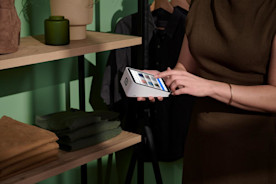Table of contents
The retail landscape is transforming rapidly in 2025 thanks to shifting consumer preferences, technological advancements, and complex economic headwinds. With the rise of trends like loyalty program adoption and a renewed focus on brick-and-mortar experiences, retailers are getting creative to entice customers to open their wallets.
To identify the top trends shaking up the Canadian retail industry, we partnered with Bredin to survey 500 business leaders and 1,000 consumers on their habits and outlook.
We discovered that even amid economic uncertainty, people are still returning to their favourite brands to shop – they just have different expectations. From seamless omnichannel experiences to technology-driven marketing strategies and new revenue models, retail leaders are stepping up to the plate to stand out.
Whether you run an online business or a brick-and-mortar store (or a bit of both), this list of top retail industry trends will help you navigate challenges and think of a brighter future in 2025.

Retailers are using more technology than you think — and it’s paying off.
Retail leaders across Canada are going all-in on technology, and it’s reshaping the industry.
Automation and AI-driven tools are helping them save time and improve processes, both in terms of customer-facing functions and behind-the-scenes solutions.
If you love the idea of auto-generated SEO-friendly product descriptions or real-time inventory tracking, you’re not alone. Canadian retail leaders told us their top three use cases for automation are inventory management, automated email marketing campaigns, and copywriting.
Canadian consumers are also enjoying sales- and payment-related technologies such as mobile apps (53% of them like engaging with one), automated appointment reminders (62% of them appreciate that feature), and self-checkout (66% of them enjoy paying that way). Though, as exciting as new integrations are, don’t underestimate the power of an informative website: 71% of consumers in Canada say they’re likely to engage with yours.
Retailers are hopeful about the short-term ROI of technology adoption. Roughly two-thirds of Canadian retail leaders cited marketing, reporting, payments and inventory management as the most impactful areas for automation in the next year. If the idea of optimizing all these aspects of your business feels overwhelming, pick one pain point and start researching how technology could help you to improve it. You’ll be glad you did it.
Retailers know new revenue paths are important, but they need to start pursuing them.
Between potential U.S. tariffs and the rising cost of living, Canadian retailers know they need to embrace new revenue paths to survive and grow. A majority of them (69%) told us that adding supplemental offerings beyond selling retail items is important to their growth plans.
However, there’s a difference between knowing something and doing it. Despite saying they need new lines of business, retail leaders haven’t experimented much in the last year. Less than one-third of them reported testing out avenues such as events (31%), a membership program or club (28%), or adding new supplemental products or services (23%) in the last year.
Diversification isn’t just about extra money on the top line of your balance sheet – it can expand your customer base and strengthen loyalty. In an increasingly uncertain world, offerings like subscriptions (62% of retailers believe that they could generate a significant ROI) or exclusive events can give you an edge and deepen your relationships with your community.
Retailers must get creative to get hesitant consumers spending in 2025.
Sixty-six percent of Canadian retailers anticipate increasing their prices over the next 12 months, and 23% said those price hikes will be significant. Meanwhile, 56% of Canadian consumers say they’ve cut back on retail purchases over the past year.
Where does this leave business leaders struggling with rising costs? Creativity will be key in getting cautious consumers to spend, and retail leaders are doubling down on marketing. Over two-thirds of retailers have increased online marketing and social media efforts as a result of economic pressures.
Social media is important, but email and texting strategies are top of mind for Canadian consumers when it comes to direct communication. Sixty-five percent of Canadian consumers told us they prefer retailers use it to communicate with them. And nearly 40% of those same consumers said they preferred receiving text messages from brands. These channels underscore the importance of personal, one-on-one interactions. Learn how to leverage them and you’ll have an advantage in the retail game.
There are also ways to get creative with payments, especially if your business caters to a younger client base. While the masses still see traditional register service as the most convenient, you may be leaving money on the table without providing other checkout alternatives. More than half of the Canadian consumers we asked found self-service kiosks(62%) and in-app pay (51%) to be convenient, and 52% said they found it convenient to pay using mobile wallets.
A solution like Square Point of Sale can help you accept a variety of payments through different channels, from purchases made with Apple Pay to sales made through Instagram. The idea is to meet customers where they are and entice them to open their wallets.
Balancing brick-and-mortar quality and online convenience will be key.
In-store retail isn’t dead. If anything, it’s having a resurgence. People are craving real-life interactions in a digital world, and retailers are learning how to create seamless omnichannel experiences in 2025.
From product demos to interactive test drives and classes, 71% of Canadian retailers believe that in-store experiences are key to future success. Canadian consumers agree: 83% rate their in-store experience positively. That said, online stores are still part of the equation, with nearly 80% of consumers enjoying a positive experience shopping online.
It will be crucial to balance online and offline efforts to create a robust, seamless brand experience across touchpoints. Think beyond the typical marketing funnel: The future of retail is more dynamic. A consumer might see a product on TikTok, purchase it on your website and later return it in-store, where they come across information about your next in-person event.
While these touchpoints and convenience are great for your customers, it also means they’ll likely set the bar even higher for omnichannel retail experiences moving forward.
Personalization and alerts efforts aren’t annoying – in fact, they’re vital.
Do you want repeat business? Invest in personalization. Not only do customers crave it, but a majority of Canadian consumers (58%) told us they either approve or have no strong opinion about their data being used by retailers to improve the retail experience or create new or customized products and services. If you’re wondering where to begin, start by personalizing communications, from targeted push alerts to small touches like using a client’s name in a shipping update email.
Loyalty programs are expected to remain popular in 2025, and they offer the biggest opportunity to customize your interactions with shoppers. When asked what they find most valuable about loyalty programs, 84% of Canadian consumers say they look for exclusive discounts and 85% want the ability to earn rewards. Also, 61% of Canadian consumers told us they find loyalty program alerts and notifications valuable – a key finding, as these communications can create crucial opportunities for personalized offers and upselling.
Retail business leaders are seeing the value of loyalty and rewards programs too: 77% say their loyalty program fosters repeat visits, 76% say it helps increase order/basket size and 74% agree that it drives ROI. If you’re feeling intimidated by the idea of setting one up, turn to your POS provider and other third-party software to explore your options.
The [previous] marketing integration didn’t work well, and there were very few options. Now I’m using Square Loyalty and Square Marketing. These tools let me automate offers, customize email campaigns, and create special birthday offers for our loyal customers.”
Ryan Nesci → Co-Owner Amici Food & Beverage, Ontario, Canada
Retailers need to rethink hiring for the long term.
Canadian retailers are reeling from recent changes to the Temporary Foreign Worker Program (TFWP), according to the Retail Council of Canada. Many retail business leaders rely on temporary workers to bridge gaps in a tight labour market. And nearly three in four Canadian retail leaders say that their business has experienced significant or moderate pressure as a result of increasing wages or new wage laws.
Despite those difficulties, 57% of retail leaders told us that hiring has become much or somewhat easier in the past year. But in an industry where employee turnover is high and seasonal hiring is a regular practice, it may be time to switch gears and think longer-term.
Of the 14 retention initiatives we asked about, none were used by more than 33% of Canadian retail leaders who responded to our survey. Yet 62% of those same retailers said they spent significantly or somewhat more time on hiring than the previous year.
Retaining existing staff by establishing clear career paths is therefore a smart move. It’s something that only a quarter of retail leaders told us they do, but it helps keep local and institutional knowledge on hand longer to better serve customers.
Retailers are investing in the future.
While the retail industry has seen its share of difficulties in the past few years, Canadian retail leaders told us they’re still planning to invest in their businesses.
In spite of – or perhaps because of – recent challenges, retail leaders say they’re expanding most in three key areas in 2025: Increasing the number of items or services offered, investing in an online store and creating or growing a loyalty or rewards program. However, it’s worth noting this survey was conducted before the levying and suspension of tariffs by the U.S. took place in January.
Retail businesses will always be evolving, and the possibility of trade barriers and workforce changes have added uncertainty. That said, the opportunity to embrace technology to automate and personalize the customer experience continues to open new doors.
Mapping out future growth doesn’t require a complete revamp of your efforts. Sometimes it just means embracing a new tool or implementing one key change to diversify revenue streams.
Square is easy to use for both my employees and my customers. Having everything on a single online platform is fantastic. No files saved on a computer. Everything is accessible in two and a half seconds with Square.”
Dimitri Chapuis → President and Business Administrator of Papillote & Cie, Quebec, Canada
For more insights on how Canadian retail store owners are innovating in 2025, dig deeper into the biggest trends in the 2025 Square Future of Retail report.
![]()
![]()











